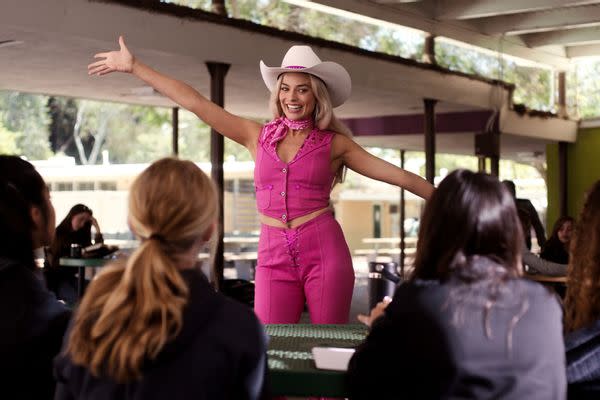We did Barbenheimer, the "Barbie" and "Oppenheimer" double feature. You should too

"What happens to stars when they die?" J. Robert Oppenheimer excitedly muses to his Berkeley colleague Haakon Chevalier at a cocktail party. Chevalier is intrigued. "Do stars die?" Exchanges like this elevate Christopher Nolan's "Oppenheimer" from a mere biopic to a full-sensory artistic experience, tugging at mind and soul.
It also primes us to better appreciate the existential panic that coldcocks Stereotypical Barbie at a parallel moment in Greta Gerwig's "Barbie." Margot Robbie's living doll is throwing a Barbieland rager and dancing merrily when, seemingly out of nowhere she yells out, "You guys ever think about dying?"
Greetings from Life After Barbenheimer, the five-hour multiplex event of the summer inviting moviegoers to pair viewings of "Oppenheimer" and "Barbie."
Though it's unlikely the extremely online folks who conceived the Barbenheimer meme expected the movies would have much in common, it turns out that they do. One takes the audience on a deep-sea swim through existential angst as its protagonists wrestle with the reality-altering impact of what they're doing to eradicate a vicious evil. The other is "Oppenheimer." Both wrestle with death, humanity's place in the universe and dark stars.
And the main question is which to watch first: Nolan's rumination on the weight of inspired genius, or Gerwig's comedic reassessment of Mattel's famous toy?
Either works, and each is guaranteed to yield a wide array of takeaways beyond whether the movie was good. Prepare to have your perception altered … temporarily. If nothing else, the marathon yields fodder for more expansive conversation than, "What did you think?"
Barbenheimer's allure is in the juxtaposition of themes and visual tones. "Oppenheimer" is a serious account of Oppenheimer's rise and his regret over unleashed the atomic bomb on humanity, anchored by Cillian Murphy's fervent, focused performance.
"Barbie" follows Robbie's Stereotypical Barbie on a quest from Barbieland – "where all problems of feminism and equality can be solved," according to Helen Mirren's narrator – to the real world, where inequality and misogyny are the status quo.

Margot Robbie as Barbie in "Barbie" (Courtesy of Warner Bros. Pictures)Universal Pictures, the distributing studio for "Oppenheimer," and "Barbie" home studio Warner Bros. Pictures, weren't planning a collaboration to ensure mutual box office success. It was the opposite.
"Oppenheimer" is Nolan's first non-Warner Bros. Discovery release since Warner's previous owners WarnerMedia announced its intention to release all its films scheduled to be released in 2021 on its streaming service, formerly known as HBO Max. Nolan responded by decamping from Warner, which distributed his films for nearly two decades at that point. Scheduling "Barbie" to be released on the same date as "Oppenheimer" is both a spiteful move and a standard counterprogramming. In theory their presumed audiences and themes couldn't be more disparate.
As of Saturday that estimation proved somewhat accurate. "Barbie" enjoyed the biggest opening day for a theatrical release in 2023, raking in $70.5 million between preview ticket sales and same day, according to Variety. "Oppenheimer" had a decent showing too with an opening day take of $33 million putting it well on its way ranking among R-rated movies that scored the biggest opening weekend.
Both are helmed by Oscar-nominated directors with an intellectual bent, reflected in the existential undertones burbling throughout each. Warner probably gambled "Barbie" would peel away some of Nolan's potential opening weekend box office before Barbenheimer took off.
Not so. In fact, I suspect as more people see the movies in tandem, we'll realize these intended box office rivals are apt partners.
As for whether to Barbenheimer, i.e. "Barbie" first, with a Manhattan Project chaser, or Oppenbarbie, that depends on whether you want to close with a sense of lively optimism or in awe of Nolan's gorgeously grim vision. Each has its merits.
Consistent with Nolan's aesthetic, "Oppenheimer" is darker despite the filmmaker's color usage to not only differentiate between timelines and perspectives but steep us in the political and social energy of each era. When Oppenheimer is in his prime the colors are brightest, and the wide vistas of New Mexico pop off the screen. As he falls under suspicion for un-American activities Nolan uses a filter that cools the liveliness from the colors; these scenes are encapsulated under the heading of "Fission."
Eventually, the world becomes encased in black and white, described as "Fusion." Both describe destructive forces that commence on an atomic level, but fusion is far more devasting – and Nolan employs it figuratively in a way that definitively crystallizes as the story folds together in the end.
It also may be helpful to know that "Oppenheimer" is a three-hour commitment. The runtime for "Barbie" is a slimmer one hour and 54 minutes.

Robert Downey Jr is Lewis Strauss and Cillian Murphy is J. Robert Oppenheimer in "Oppenheimer" (Universal)
Their effectiveness as a complementary vision also depends on what the viewers bring to the experience. In one view "Oppenheimer" is a cautionary tale about on the destructive nature of the male ego, an idea given central cartoonish placement in "Barbie" thanks to Ryan Gosling's Ken and his lack of purpose apart from Barbie.
A feminist lens might notice Oppenheimer's womanizing as a contradiction within the film. Nolan includes his recruitment of Lilli Hornig (Olivia Thirlby) to the overwhelmingly male Los Alamos team of the Manhattan Project after Hornig advocates for herself: She confronts Oppenheimer about the insult at her being asked to take a typing test, dryly suggesting that her Harvard Ph.D. could be put to better use.
"Barbie," meanwhile, achieves the wonderful and uncommon feat of making a properly tangible villain out of patriarchy, depicting it as unnecessarily obstructive and divisive. Barbieland's peaceful efficiency relies on its culture of mutual admiration and support, which Barbie doesn't find in our world, whether from the girl she thinks she's meant to inspire or the men who want to put her in a box.
This action casts a fuschia glow around the sexism in "Oppenheimer," which Nolan doesn't downplay.
Another might marvel at the atomic age bridge linking "Oppenheimer" and "Barbie," where the multi-level Dreamhouse cubes call to mind midcentury case study houses. This lends itself to picturing the surreal Barbieland as the afterlife to the "Now I am become Death, the destroyer of worlds" connotations of "Oppenheimer."
That film's annihilative final frame sticks with a person, even through "Barbie." I assure you that knowing this spoils none of the turns making "Oppenheimer" a complete masterpiece, but it's something a person should consider when deciding which movie to see first. Since that image embedded itself in my brain regardless, I was happy to have gone with Oppenbarbie, taking in Nolan's movie first. "Barbie" closes with a big laugh and a toy parade through its end credits, staving off night terrors related to a nuclear apocalypse.

Margot Robbie as Barbie and Ryan Gosling as Ken in "Barbie" (Courtesy of Warner Bros. Pictures)We may not walk away from "Oppenheimer" with a firmer grasp on quantum mechanics or theoretical physics, or leave "Barbie" feeling differently about the doll. Taken together they're the closest any of us may come to knowing what it's like to pass through a black hole and emerge into a cheerier existence. And they grant accessible depths to the respective wisdom they have to bestow on the audience – such as, "Humans only have one ending. Ideas live forever."
Is that from "Barbie" or "Oppenheimer"? Maybe you already know. If not, you may appreciate how well that line could fit in either if you watch them back-to-back.
Want a daily wrap-up of all the news and commentary Salon has to offer? Subscribe to our morning newsletter, Crash Course.
How (not?) to Barbenheimer
There's no wrong order to this double feature, although there are saner ways to do it than I did, which was to buy a ticket "Oppenheimer" and purchase the first "Barbie" screening at least three hours after the start time for Nolan's film in the same theater. This cut the time between the end of one screening and the start of the other to a sliver, but it also made the viewing experience feel more seamless. Plus, the theaters were across the hallway from each other.
Then again, that means staring at a screen almost non-stop for five hours including preview trailers. So I recommend a morning viewing of one film, a break for lunch – or a good stretching break – before returning for an afternoon screening. (It's a great reason to take a personal day.)
Regardless of how you do it, be sure to buy your tickets in advance at a theater with superior seating, preferably one with reclinable loungers. Taking those comfort and ergonomic considerations seriously makes it easier to give yourself over completely to the accidental genius of this pairing. As Murphy's Oppenheimer tells his Berkeley students about the occasionally contradictory nature of quantum mechanics, "It's paradoxical, but it works."
"Barbie" and "Oppenheimer" are now playing in theaters nationwide.
Read more
about summer movie releases
